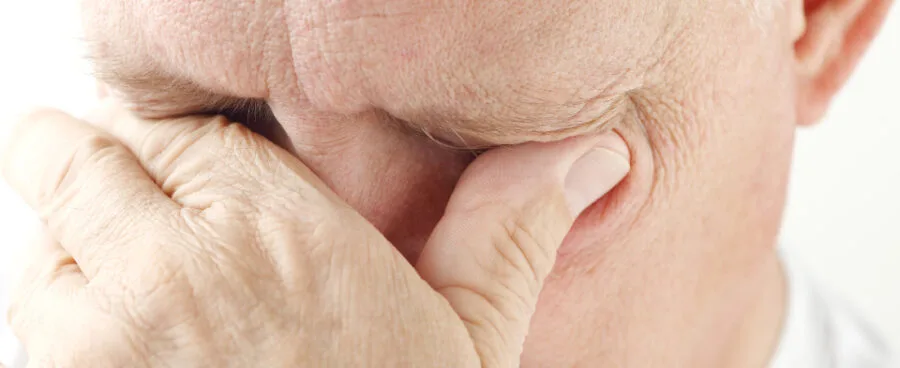Why are my eyes Dry and Watery?
G&G Eye Doctors: Brampton | Cambridge

Conquering Dry Eyes:
A Comprehensive Guide for Dry Eye Syndrome
Do you ever find yourself squinting at your computer screen, struggling to focus on your favorite
book, or yearning for relief from a gritty, stinging sensation in your eyes? If you're over 40, you're
not alone. Dry eye disease, a chronic condition affecting millions of adults, becomes increasingly
common with age.
This condition, while not sight-threatening, can significantly disrupt your daily life and impact your
overall well-being. But fear not! This guide delves deep into the world of dry eyes, equipping you
with the knowledge and strategies to manage and overcome this frustrating condition.

Understanding Dry Eyes: A Battle on the Tear Film Front
Our eyes rely on a complex tear film, a three-layered shield that protects, lubricates, and nourishes the cornea, the eye's outermost surface. This tear film comprises three crucial layers:
- 1. Oil Layer (Lipid Layer): Produced by meibomian glands in the eyelids, this oily layer acts like a seal, preventing tears from evaporating too quickly.
- 2. Watery Layer (Aqueous Layer): The middle layer, produced by the lacrimal glands, makes up the bulk of the tear film and keeps your eyes hydrated.
- 3. Mucin Layer (Mucous Layer): Produced by goblet cells in the conjunctiva (the white part of the eye), this mucous layer helps spread the tears evenly over the cornea.
Dry eye disease disrupts this delicate balance. It can occur due to insufficient tear production, excessive tear evaporation, or a combination of both.

The Telltale Signs: Unveiling Dry Eye Symptoms
Dry eye disease often manifests through a constellation of symptoms, including:
- Gritty sensation: Feeling like you have sand or dust in your eyes.
- Burning or stinging: A burning, stinging, or itching sensation in your eyes.
- Foreign object sensation: The feeling of having a foreign object lodged in your eye.
- Redness: Redness of the whites of your eyes.
- Blurred vision: Blurry or fluctuating vision, particularly noticeable during extended screen time.
- Light sensitivity: Increased sensitivity to bright lights or sunlight.
- Watery eyes: Ironically, some people with dry eye disease experience excessive tearing, a reflex response to the irritation caused by dry eyes.
These symptoms can vary in intensity and may worsen in dry environments, during prolonged screen time, or upon waking up in the morning.
Unveiling the Culprits: What Causes Dry Eyes?

Several factors can contribute to dry eye disease:
- Age: As we age, tear production naturally decreases.
- Hormonal fluctuations: Women, particularly during pregnancy, menopause, and due to hormonal birth control, can experience changes in tear production.
- Medical conditions: Certain medical conditions like Sjogren's syndrome, rheumatoid arthritis, and lupus can affect tear production.
- Medications: Some medications, such as antihistamines, decongestants, and antidepressants, can have dry eye as a side effect.
- Environmental factors: Dry, windy climates, air conditioning, and prolonged exposure to digital screens can exacerbate dry eye symptoms.
- Lifestyle factors: Smoking, excessive caffeine intake, and dehydration can contribute to dry eyes.
Beyond Eye Drops: Exploring Lasting Treatments for Dry Eyes
While lubricating eye drops [3] can provide temporary relief, they don't address the underlying cause of dry eye disease. Here, we explore a range of solutions to achieve lasting dry eye management:
- Lifestyle modifications: Simple changes like reducing screen time, using a humidifier at night, avoiding smoky environments, and staying hydrated can significantly improve symptoms.
- Warm compresses: Applying warm compresses to your eyelids for 10-15 minutes a day can help melt clogged oils in the meibomian glands, improving tear quality.
- Lid hygiene: Regularly cleaning your eyelids with a gentle cleanser removes bacteria and debris that can contribute to dry eyes.
- Tear duct plugs: Tiny plugs inserted by your doctor into the tear drainage ducts can help conserve tears by preventing them from draining away too quickly.
- Prescription medications: In some cases, your doctor may prescribe medications like cyclosporine Restasis® [8] to suppress inflammation that hinders tear production.
- Punctal plugs: These are dissolvable or permanent inserts placed in the tear drainage ducts to achieve a similar effect as tear duct plugs.
- Nutritional supplements: Omega-3 fatty acids, particularly those found in fish oil, may improve tear quality and reduce inflammation.

It's important to note that there's no one-size-fits-all solution for dry eyes.
Consulting your Optometrist is crucial for determining the cause of your dry eye and developing a personalized treatment plan.
